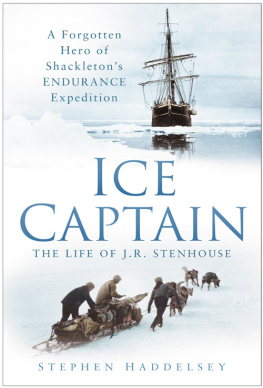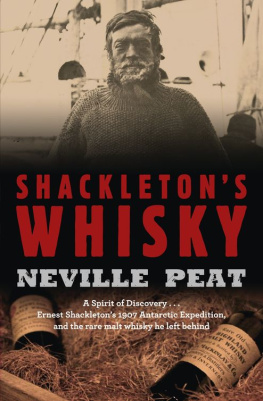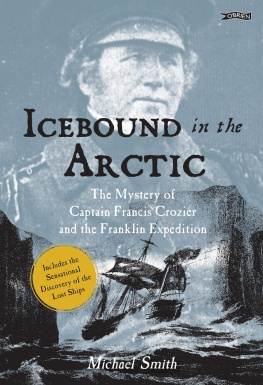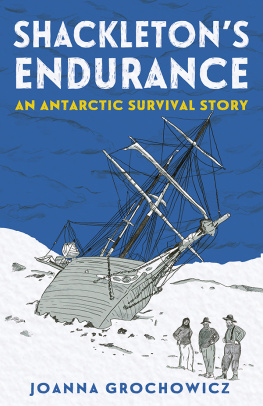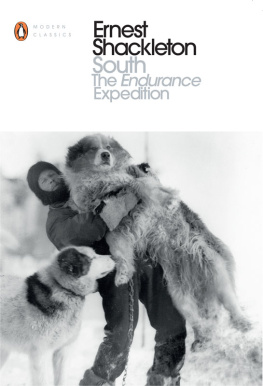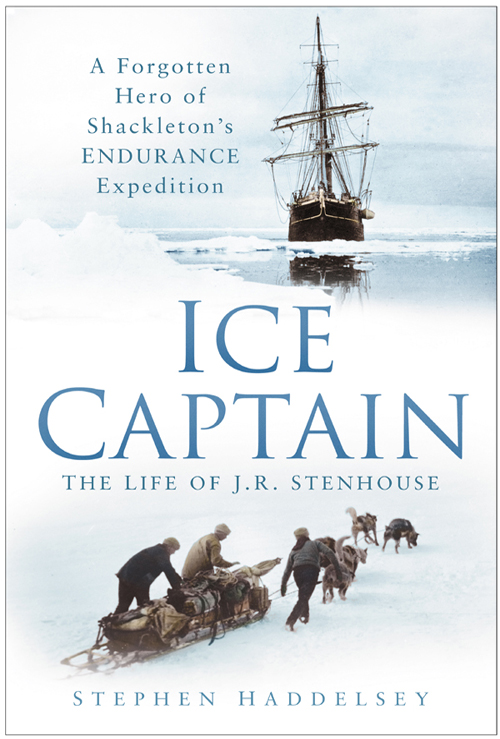ICE CAPTAIN
ICE CAPTAIN
THE LIFE OF J.R. STENHOUSE
STEPHEN HADDELSEY

First published in 2008
The History Press
The Mill, Brimscombe Port
Stroud, Gloucestershire, GL5 2QG
www.thehistorypress.co.uk
This ebook edition first published in 2011
All rights reserved
Stephen Haddelsey, 2008, 2011
The right of Stephen Haddelsey, to be identified as the Author of this work has been asserted in accordance with the Copyrights, Designs and Patents Act 1988.
This ebook is copyright material and must not be copied, reproduced, transferred, distributed, leased, licensed or publicly performed or used in any way except as specifically permitted in writing by the publishers, as allowed under the terms and conditions under which it was purchased or as strictly permitted by applicable copyright law. Any unauthorised distribution or use of this text may be a direct infringement of the authors and publishers rights, and those responsible may be liable in law accordingly.
EPUB ISBN 978 0 7524 7540 0
MOBI ISBN 978 0 7524 7539 4
Original typesetting by The History Press
For my nieces, Anna and Rachael
The vast terraqueous Globe Ive rambled oer,
But in myself retird discoverd more.
The Life and Errors of John Dunton
CONTENTS
LIST OF MAPS
PREFACE
E ver since news of its astonishing fate broke upon a war-weary world some ninety years ago, Sir Ernest Shackletons Endurance Expedition has been considered one of the supreme examples of polar exploration and survival against the odds. In that incredible story it is generally acknowledged that one of the most dramatic episodes is the epic 800-mile small-boat voyage across the storm-lashed Antarctic Ocean, from Elephant Island to South Georgia. It is less well known, however, that the expedition gave birth to not one but two heroic feats of seamanship, with matters of life and death hinging upon each in equal measure. This book tells, for the first time, the story of the man responsible for that other, less celebrated but equally remarkable odyssey: Joseph Russell Stenhouse.
Shackletons trial began in the Weddell Sea; but, on the other side of the frozen continent, the expeditions second ship, the Aurora, suffered a fate which closely paralleled that of the Endurance. Torn from her moorings and driven out to sea by a ferocious gale, she, too, became trapped in pack-ice which, for ten months, sawed relentlessly at her wooden hull. Although the ice lifted the 600-ton ship from the water like a toy and strained her timbers and joints to breaking point, she, unlike the Endurance, eventually escaped its grip. With her rudder smashed and water cascading from her seams, under Stenhouses command, the Aurora then embarked upon her own extraordinary and desperate voyage to reach safe harbour. That she survived at all was, in the words of Frank Worsley, entirely due to her captains superb seamanship. And Worsley knew what he was talking about: as master of the Endurance, it was he who had navigated the ships whaleboat, the James Caird, to South Georgia.
But Stenhouses command of the Aurora was just one episode in a career packed with extraordinary adventures. As with so many of his fellows, the Antarctic undoubtedly became the linchpin of his career. Unlike some, however, upon his return from the frozen south in 1917 Stenhouse did not experience any debilitating sense of anti-climax or bathos. In particular, the war offered him an opportunity to excel, both at sea and on land, and to build upon an already firmly established reputation for courage and daring. During its course he earned the Distinguished Service Cross for sinking an enemy submarine and the Distinguished Service Order and the French Croix de Guerre for his part in the Allied struggle with Bolshevism in Murmansk and Archangel. These, when added to the Order of the British Empire and the Polar Medal, which he received for his Antarctic service, made him one of the most highly decorated of all Heroic Age explorers. He also embraced the opportunity to return to Antarctic waters, not with the poorly conceived and goalless Quest Expedition which fell apart after the death of Shackleton in 1922, but as master of Captain Scotts Discovery, on which he shared responsibility for one of the most detailed and comprehensive surveys of the worlds oceans ever undertaken.
In the difficult postwar years, Stenhouse, with so many others, experienced periods of unemployment and he became involved in a variety of money-making schemes. Some, such as his hunt for pirate gold on Robert Louis Stevensons Treasure Island, smacked of romance and desperation in equal measure; others, such as his attempt to pioneer Antarctic tourism in the 1930s, based upon an altogether more robust premise. But, be they fantastical or rational, he brought to every occupation the same levels of determination and resourcefulness that had enabled him to bring the crippled Aurora back to safety.
Almost as extraordinary as the range of Stenhouses activities is the remarkable survival of the record of his adventures. He was both a diarist and a regular letter-writer and many of these documents have been preserved by his family. Inevitably, some items have been lost or destroyed in the decades since his death, but the residue constitutes what must be one of the most comprehensive archives of any Heroic Age Antarctic explorer in private, or, perhaps, even in public hands. It allows us to observe Stenhouse in a range of circumstances and environments, before, during and after the Endurance Expedition. We see him as an apprentice, lashed with spume and spray as his first ship rounded Cape Horn in a tempest; sledging across the Antarctic sea-ice of McMurdo Sound to break into the time capsule of Scotts Discovery hut; dodging the bullets of Bolshevik soldiers among the pine forests of the Kola Peninsula; and fighting to salvage ships crucial to the Allied war effort in the Red Sea. These glimpses combine to reveal a man whose courage, resourcefulness and resilience impressed themselves indelibly on those who served with him and earned for him their respect, admiration and enduring affection.
And yet Stenhouse also suffered from prolonged and debilitating bouts of depression and, in certain circumstances, he could demonstrate an inclination to brag, a willingness to strike first and ask questions later and so rigid an adherence to shipboard discipline that he sometimes resembled a martinet of the old school. Operated upon by different pressures and different personalities, the balance of his multifaceted character could shift and change, and the very qualities that enabled him to save the Aurora in 1916 led to disastrous discord and disunity on board the Discovery in 1927. The fact that these conflicts and inconsistencies can be observed against an ever-changing backdrop of adventure and action, and that they are described in Stenhouses own words with all the immediacy of felt experience, has made his life fascinating to research and I can only hope to read.
ACKNOWLEDGEMENTS
I first became familiar with the career of J.R. Stenhouse when researching that of his friend, the equally daring Heroic Age explorer, Frank Bickerton. The lives and adventures of both men have struck a chord with practically everyone I have contacted during the course of my years of research but, while every facet of Bickertons life had to be pursued with the tenacity of the most dedicated detective, the vast bulk of the material used in preparing this biography was made available to me after only one or two telephone calls and letters. Practically every document upon which this biography is based, including diaries, letters, notebooks, photographs and memoranda, lies in the hands of Stenhouses family in particular, in those of his only daughter, Mrs Patricia Mantell, and his granddaughter, Sarah Mantell. To Mrs Mantell and to Sarah, therefore, I should like to offer my most sincere thanks for all their support, encouragement and hospitality. Without their generosity and enthusiasm this book could never have been written. Furthermore, by preserving such an expansive archive, they have not only ensured that there is hardly a single gap or ambiguity in Stenhouses remarkable story, they have also done a great service to the history of Antarctic exploration.

